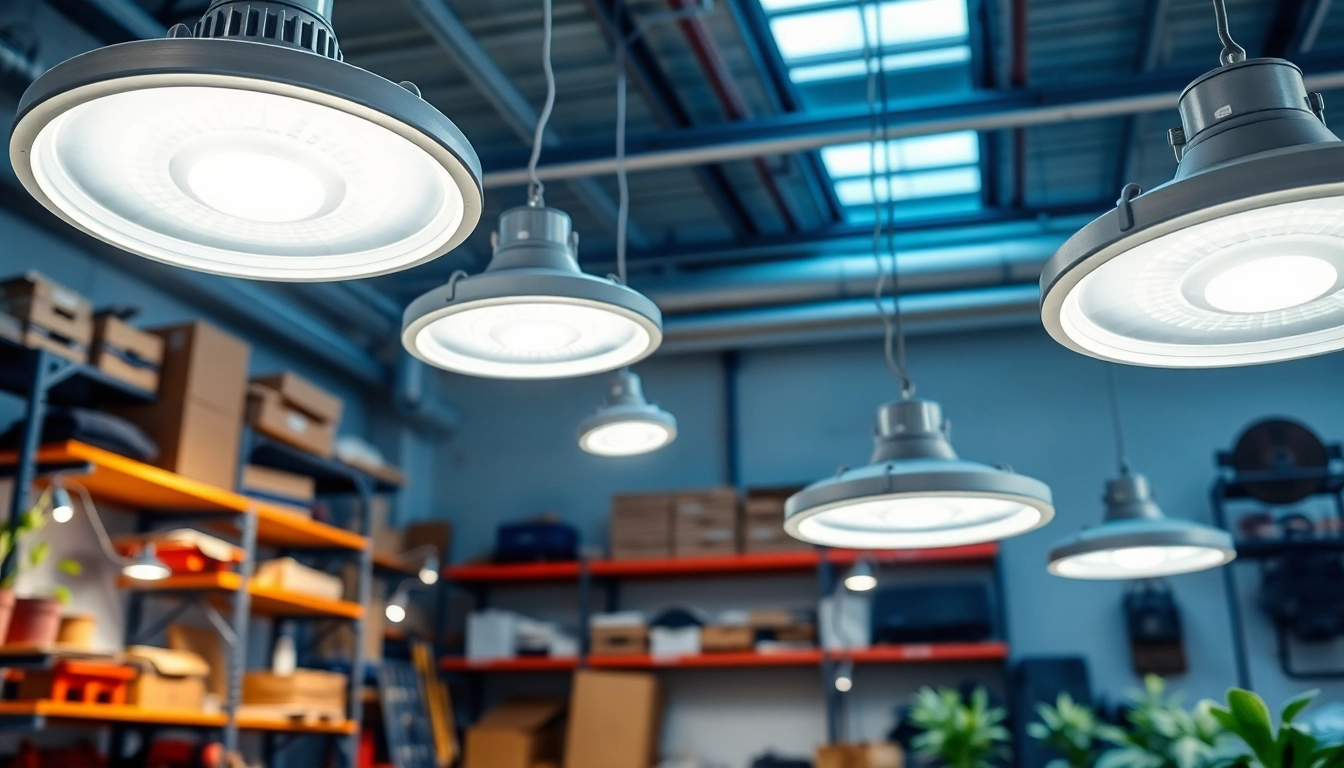Understanding Vapor Tight Technology
What is Vapor Tight?
Vapor Tight lighting fixtures are designed specifically to prevent moisture, dust, and other contaminants from entering the unit. This feature is paramount for maintaining optimal performance and longevity of the fixtures, especially in environments where exposure to moisture is common, such as in food processing plants, warehouses, and outdoor installations. The design typically includes weatherproof seals and rugged housing that can withstand not only moisture but also impacts and vibrations. The result is a durable lighting solution that operates effectively in challenging conditions.
Benefits of Vapor Tight Fixtures
Choosing Vapor Tight lighting solutions offers numerous benefits that extend beyond basic illumination. One significant advantage is their enhanced durability; built to withstand harsh environments, these fixtures often have an IP65 or higher rating, indicating resistance to dust and water. This level of protection can lead to reduced maintenance costs and less frequent replacements.
Another benefit is energy efficiency. Many modern Vapor Tight fixtures utilize LED technology, which consumes less energy than traditional incandescent or fluorescent lights. This efficiency is particularly important for commercial facilities aiming to lower operation expenses and reduce their carbon footprint.
Additionally, Vapor Tight lighting provides consistent performance in varying temperatures, ensuring that environments such as cold storage or outdoor areas are adequately illuminated throughout the changing seasons. These fixtures can improve safety and visibility, thus enhancing working conditions and lowering the risk of accidents.
Applications of Vapor Tight in Various Environments
Vapor Tight fixtures find applications in a wide range of environments where traditional lighting solutions may fail. Common scenarios include:
- Industrial Facilities: In manufacturing plants, Vapor Tight fixtures help maintain visibility in locations prone to dust, debris, and moisture.
- Food Processing: These fixtures are ideal for kitchens and food storage areas, where sanitation and moisture management are critical.
- Agricultural Settings: In barns and greenhouses, where humidity levels are high, Vapor Tight lighting contributes significantly to safety and functionality.
- Outdoor Spaces: Many parks, parking lots, and walkways utilize these fixtures to provide reliable lighting that withstands weather conditions.
- Public Transit Hubs: Train stations and bus depots benefit from the durability and visibility provided by Vapor Tight technology.
Choosing the Right Vapor Tight Lighting
Factors to Consider When Selecting Vapor Tight
When selecting Vapor Tight fixtures, several factors come into play that can influence your decision:
- Environment: Assess the specific conditions where the fixtures will be installed. Is it an outdoor site, a warehouse with exposure to dust, or a food production area? Each environment will dictate different requirements for IP ratings and fixture types.
- Fixture Style: Various designs are available including linear, square, and circular options. Choose based on aesthetics and functional needs.
- Light Output: Calculate the needed lumen output by considering the size of the space and the activities that take place therein.
- Energy Efficiency: Look for fixtures with high lumens per watt metrics to maximize energy savings.
- Installation Requirements: Consider whether the fixtures allow for easy installation and whether you need additional components such as mounting brackets or connectors.
Comparing Different Types of Vapor Tight Fixtures
Not all Vapor Tight fixtures are created equal. Below is a comparison of the main types available:
- LED Vapor Tight: These are the most energy-efficient options, offering high lumen output with low energy consumption. They have a long lifespan, which reduces maintenance costs over time.
- Fluorescent Vapor Tight: While less efficient than LEDs, they might be suitable for certain budgets. However, they have a shorter life span and can be less durable over time.
- Incandescent Vapor Tight: Generally not recommended for new installations due to their inefficiency and shorter lifespan, but still found in older setups.
Energy Efficiency Ratings for Vapor Tight Lighting
Understanding energy efficiency ratings is critical in choosing the right Vapor Tight lighting. Look for fixtures that are Energy Star certified, ensuring they meet stringent energy efficiency guidelines. Additionally, check their lumen output against wattage to assess efficacy. The ratio of lumens per watt (LPW) is a good indicator of how much light is produced for each watt consumed. Higher LPW ratios signify better efficiency, allowing you to optimize energy costs while maintaining adequate lighting.
Installation Procedures for Vapor Tight Fixtures
Preparing Your Space for Installation
Before proceeding with the installation of Vapor Tight fixtures, preparation is vital. Start by assessing the installation area:
- Ensure the location is free of obstructions and has proper access for installation.
- Review electrical requirements to confirm compatibility with existing wiring.
- Gather all required tools and materials, including ladders, screwdrivers, connectors, and safety gear.
- Consider whether the installation will be done by professionals or as a DIY project, and follow all relevant safety codes and regulations.
Step-by-Step Guide to Install Vapor Tight Lights
Follow these general steps to properly install Vapor Tight lighting fixtures:
- Turn Off Power: Safety is paramount; ensure the power to the existing fixtures is turned off at the circuit breaker.
- Install Mounting Bracket: If required, install the mounting bracket according to the fixture’s specifications, ensuring it is anchored securely.
- Connect Wiring: Connect the new fixture wiring to the electrical supply, ensuring correct alignment of live, neutral, and ground wires.
- Secure the Fixture: Attach the Vapor Tight fixture to the mounting bracket, ensuring that all seals are properly aligned.
- Restore Power: Finally, turn the power back on and test the functionality of the new lighting.
Common Installation Mistakes to Avoid
While installing Vapor Tight fixtures, it’s essential to avoid common pitfalls that could affect performance:
- Neglecting Safety: Always prioritize safety by using the appropriate protective equipment and ensuring the power is off before starting work.
- Incorrect Wiring: Double-check all connections to prevent electrical faults.
- Improper Sealing: Ensure seals are correctly placed to maximize moisture protection; leaks can lead to fixture failure.
- Ignoring Local Codes: Adhere to local building and electrical codes that might require permits or inspections.
Maintenance and Care for Vapor Tight Lighting
Cleaning Methods for Vapor Tight Fixtures
Regular maintenance of Vapor Tight fixtures ensures their longevity and optimal performance. Cleaning is essential, especially in environments prone to dirt and contaminants:
- Exterior Cleaning: Wipe down the fixture’s exterior with a damp cloth and mild detergent regularly.
- Lens Cleaning: Ensure that the lens is clean for maximum light output; use a non-abrasive cleaner to avoid scratching.
- Inspect Seals: Periodically check seals for wear or damage, replacing them as necessary to maintain waterproof integrity.
Frequency of Maintenance Checks for Optimal Performance
Establishing a regular maintenance schedule is vital. A good practice is to conduct thorough checks every six months. This schedule allows for:
- Identifying and addressing potential issues before they escalate.
- Maintaining the aesthetic appearance of the fixtures.
- Ensuring devices are operating at their designed efficiency.
Identifying and Replacing Faulty Components
Over time, components within Vapor Tight fixtures may degrade. Being able to identify and replace these is crucial for the fixture’s operation:
- Identifying Faulty Components: Common signs include flickering lights, dim outputs, or complete failures. Listen for buzzing sounds which could indicate wiring issues.
- Replacement Procedures: Follow manufacturer guidelines for replacing bulbs, ballasts, or driver units. Ensure power is always off during maintenance activities.
Future Trends in Vapor Tight Lighting
Advancements in LED Vapor Tight Technology
The shift towards LED technology in Vapor Tight fixtures has opened up numerous possibilities. Innovations include:
- Smart Sensors: Integrating motion sensors and daylight harvesting technologies can enhance efficiency and reduce unnecessary energy consumption.
- Improved Light Quality: Innovations in color rendering indices (CRI) are making it easier to achieve high-quality lighting that enhances visibility and safety.
- Remote Monitoring: Advanced systems allow for remote monitoring of lighting conditions, enabling better management of energy usage and fixture performance.
The Impact of Smart Lighting on Vapor Tight Systems
Smart lighting technology is transforming how we perceive and use Vapor Tight fixtures. Benefits include:
- Energy Management: Automated lighting systems can significantly reduce energy consumption by adjusting brightness levels based on occupancy.
- IoT Integration: Internet of Things (IoT) technology can provide real-time data on fixture performance, allowing maintenance teams to address issues proactively.
Sustainability Practices in Vapor Tight Manufacturing
Sustainability is becoming increasingly important in the manufacturing of Vapor Tight fixtures. Key trends include:
- Recyclable Materials: Manufacturers are using materials that can be easily recycled, reducing waste and environmental impact.
- Energy-efficient Production Processes: Lean manufacturing techniques are being implemented to minimize energy usage during production.




